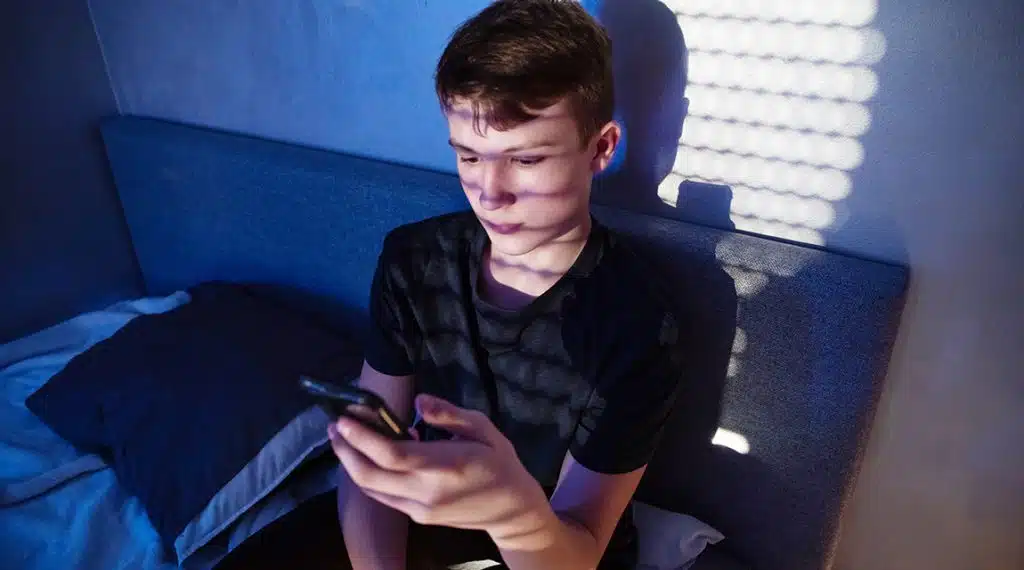The teenage years are notorious for being emotionally turbulent. Hormones surge. Teenagers’ bodies transform. School pressures mount. Individuation creates conflict at home. That teenagers go through bouts of woe isn’t surprising. What’s concerning is the depth of their melancholy and the pace at which it’s rising.
According to a new poll, 87 percent of Gen Z report struggling with their mental health. Furthermore, a recent CDC report found that nearly 60 percent of teen girls report persistent feelings of sadness or hopelessness, and close to one-third of teen girls have seriously considered attempting suicide. Why are American teens so sad?
Key Takeaways
- A 2023 poll found that nearly nine out of 10 youth ages 14–25 are experiencing mental health challenges on a regular basis,
- Gun violence, racism, social injustice, and climate change are among Gen Z’s top concerns.
- Teen girls and LGBTQ teens report worse mental health than teen boys.
- Parental support and school connectedness can protect teen girls and boys from developing mental health issues.
New Research on Teen Mental Health
The 2023 Blue Shield of California/Harris Poll surveyed 1,300 teens and young adults, and close to 90 percent reported struggling with their mental health. Moreover, 17 percent of young women, 26 percent of transgender youth, and 42 percent of non-binary youth rated their mental health as “poor.” This was compared to 9 percent of young men reporting poor mental health.
Survey participants said they experiencing mental health impacts due to gun violence, racism, social injustice, and climate change. In addition, personal issues negatively affecting Gen Z included worries about finding a job, negative body image, and family relationships.
Data from the Youth Risk Behavior Survey (YRBS) further validates the high numbers of young people who are in distress. The YRBS, a CDC analysis, tracks the mental health of US students in public and private high schools. In the most recent survey, 29 percent of teen boys and 57 percent of teen girls reported experiencing persistent feelings of sadness or hopelessness.
As the Harris Poll also showed, gay teens and teens in other marginalized groups face especially high rates of sadness, according to the YRBS survey. However, levels of sadness and hopelessness have increased in teens of every race, gender identity, and sexual orientation. They’ve increased among teens in every year of high school. And they’ve increased in all 50 states and the District of Columbia.
More Data from the YRBS on Teen Sadness
The CDC report also found that:
- 14 percent of males seriously considered suicide, 12 percent made a suicide plan during the year prior to the survey, and 7 percent attempted suicide
- Nearly 1 in 3 teen girls (30 percent) seriously contemplated attempting suicide—up nearly 60 percent from a decade ago—and 1 in 4 reported making suicide plans
- 1 in 5 girls (18 percent) experienced sexual violence in the past year—up 20% since 2017
- 1 in 10 female students and more than 1 in 5 LGBQ+ students attempted suicide
- More than half of LGBQ+ teenagers reported struggling with their mental health (The survey didn’t ask whether teens were transgender).
Why Are American Teens Struggling?
There isn’t one single reason that explains why rates of sadness and depression in teenagers is so high. There are multiple reasons why teens are so sad. And the different factors overlap and interact with one another. The bottom line is that depression is a multifactorial illness, so the causes are varied.
Why Teen Girls Are So Sad
Hormonal changes may be partly to blame for the higher rates of sadness and hopelessness, as girls reach puberty earlier than boys. Girls may also have greater genetic vulnerability such that they’re more likely to suffer from mood disorders if one parent does.
Furthermore, the trauma that some teenage girls experience due to physical or sexual abuse can’t be overlooked, nor can the differences in the way girls and boys manage their feelings. While girls tend to collapse into them, boys are more apt to act out in aggressive ways.
What About Teen Boys?
Teenage girls are not the only ones struggling. Teenage sadness is on the increase for boys, too, as the CDC report confirmed. Boys are affected by many of the same factors as girls, but the way they’re socialized means they are much less likely to report symptoms of anxiety and depression. As boys mature from toddlers to teenagers, they receive subtle and not-so-subtle messages from their families and communities that expressing vulnerability is not acceptable. As result, they’re more apt than girls to mask depression and anxiety with a tough shell.
In mental health emergencies, boys are less likely to seek out support from a friend, family member, or trusted adult. And they’re more likely to deal with painful feelings by expressing anger or engaging in risk-taking behaviors like substance abuse, driving under the influence, fighting, or criminal activities like stealing and vandalism. This is yet another reason statistics show that rates of trauma, depression, and anxiety in girls are higher than in boys.
“As we saw in the 10 years prior to the COVID-19 pandemic, mental health among students overall continues to worsen, with more than 40% of high school students feeling so sad or hopeless that they could not engage in their regular activities for at least two weeks during the previous year—a possible indication of the experience of depressive symptoms. We also saw significant increases in the percentage of youth who seriously considered suicide, made a suicide plan, and attempted suicide.”
Youth Risk Behavior Survey Data Summary & Trends Report: 2011–2021
7 Reasons Why American Teens Are Suffering
Here are some of the reasons why teens are so sad.
#1: The Impact of Social Media
On the surface, it seems that social media would spur a greater sense of connectedness, helping young people feel less lonely rather than more. In some cases, this is true. Social media can help teens maintain connections with friends and family as well as receive support and advice. However, research also shows a strong association between social media and teen depression. Young people with moderate to severe depressive symptoms were nearly twice as likely to say they used social media almost constantly.
Surveys of American high school students show that teen depressive symptoms and suicide rates increased markedly between 2010 and 2015, especially among females. And those who spent more time on social media were more likely to report mental health issues. Another study looked at 84,000 people of all ages. The researchers discovered that for girls ages 11 to 13, social media use leads to a decrease in life satisfaction.
The overemphasis on appearance that pervades social media is a big part of the problem. Hence, teens’ feelings of inadequacy can escalate as they compare themselves to curated and filtered images of celebrities, influencers, and friends.
#2: Body Image Issues
Social media clearly exacerbates both girls’ and boys’ body images issues. But it’s not the only source of those issues. Societal standards continue to elevate an “ideal” body that is unrealistic. Research shows that the desire for thinness emerges in girls as early as six years old. The same study found that 40 to 60 percent of elementary school girls are concerned about becoming too fat.
By the time they’re teenagers, a large percentage of girls are already suffering from body dissatisfaction. Among high school students, 44 percent of girls are trying to lose weight at any given time. Not all develop eating disorders, but as many as 1 in 10 young women do, according to the American Academy of Child and Adolescent Psychology.
Meanwhile, male body image and eating disorders are also becoming more common, Research published in JAMA Pediatrics found that 17 percent of teen boys had disordered eating behaviors, vs. 30 percent of teen girls. That’s a much closer ratio than in recent decades. For both boys and girls, continually self-evaluating their bodies damages self-esteem and can lead to feelings of despair.

#3: Bullying
Bullying is the act of using intimidation or aggressive behavior to create a physical or emotional sense of domination over another person. Adolescent bullying can undermine a teenager’s sense of self-worth and may negatively affect their ability to develop trusting peer relationships. Over time, bullying can lead to depression, anxiety, PTSD, and a higher risk of suicidal behavior.
According to the CDC report, 15 percent of teens experienced bullying at school. Teens also experience high rates of electronically bullying through texting and social media. Female students and LGBQ+ students were more likely to experience both cyberbullying and in-person bullying at school.
#4: Violence
Another stark reality girls routinely face is the threat or experience of sexual harassment, rape, and/or violence. The CDC report revealed record-high rates of violence toward teen girls, with almost 14 percent saying they had been forced to have sex. That means that out of every 10 teen girls, at least one—and possibly more—has been raped. Generally speaking, female students, LGBQ+ students, and students with same-sex partners were more likely to experience violence, the report found.
Moreover, many teens reported experiences of being threatened or injured with a weapon. Overall, 7 percent of high school students said they had been threatened or injured with a weapon, such as a gun, knife, or club, on school property during the year prior to the survey. Violent experiences are significant risk factors in traumatic stress and depressive symptoms.
#5: Disturbing World Events
We live in a 24/7 constant news cycle famous for its bad news bias. When young people plug into the endless array of news platforms, they’re met with a barrage of reasons to be depressed. School shootings, an environmental crisis, racial injustice, the war in Ukraine … it’s overwhelming and nonstop. Living in disturbing times that threaten young people’s sense of safety is increasing adolescents’ stress and leading to higher levels of sadness.
Explicit media coverage of horrific tragedies, such as school shootings, is also spawning increasing numbers of secondary PTSD. This condition can result from indirect exposure to fatal or life-threatening events. The increasing numbers of these events are contributing to rising rates of teen depression and anxiety.
#6: Lack of Time in Nature
In the past two years, media use among tweens and teens grew faster than in the four years before the pandemic, according to the Common Sense Census. Between 2019 and 2021, the total amount of screen media used each day went from 4:44 to 5:33 among tweens, and from 7:22 to 8:39 among teens. That’s a 17 percent increase in the last two years. And it doesn’t even include screen time while studying at school or doing homework.
According to a report by the Outdoor Foundation, a non-profit organization that encourages future generations of outdoor enthusiasts, today’s teens are spending less time outside. Participation in outdoor recreation is about 50 percent among girls ages 13 to 17, the lowest rate since the first report in 2006. A lack of time in nature—a phenomenon some refer to a Nature Deficit Disorder—is linked to higher rates of anxiety, ADHD, and depression.
#7: Low Resilience
Resilience is characterized by the ability to bounce back from upset, stress, disappointment, obstacles, and adversity. It’s determined by biological and psychological characteristics, relationships with family and friends, and environmental influences such as those at school and in the wider community.
In a study of 16- and 17-year-old teenagers found that teens have markedly low resilience, although boys had greater resilience than girls. For example, 51 percent of boys said they were not easily discouraged by failure, while only 37 percent of girls did. And 50 percent of teenage boys surveyed agreed with the statement “Coping with stress can strengthen me.” But only 39 percent of girls did the same.
In part, this may be due to societal expectations around what it means to “be a man.” Males are expected to be stronger and better able to deal with challenges and stress, so they may report higher levels of resilience even if they don’t really feel capable of coping.
The Good News: Teens Are Seeking Mental Health Resources
Despite the troubling data on teen sadness in America, the Harris Poll found a bright spot: 78 percent reported that they have talked about their emotions and mental health with others in the past year. And 71% have used resources to help address mental health challenges.
Moreover, 93 percent of the survey participants actively use self-care methods to manage their mental health. Their top self-care methods include:
- Music, movies, and TV shows
- Meditation
- Exercise
- Deep breathing
- Therapy
However, nearly two-thirds of Gen Z experienced barriers to accessing mental healthcare. The biggest barriers they reported were:
- Being embarrassed to ask for help or worried about what others would think (31 percent)
- Difficulty finding a therapist they can relate to (21 percent)
- Believing they couldn’t afford mental healthcare (20 percent)
What Parents, Providers, and School Professionals Can Do
The YRBS highlighted protective factors that can improve health outcomes in the teenage demographic. Here’s what we can do to help make a difference for young people.
School professionals: The survey pointed out that “school connectedness” (the feeling among young adults that people at school care about them) has long-lasting protective effects well into adulthood. To improve mental health in their students, schools can be proactive. They can provide education on mood disorders and how to manage them. They can also connect teens to their classmates and communities through school-based clubs, youth sports, and community outreach.
Parents: Parental monitoring is another important protective factor. This refers to parents or other adults being aware of where teens are going, who they’re with, and when they’ll return. With good parental monitoring, young people are less likely to engage in substance use, violence, risky sexual behavior, or suicidal thoughts and actions.
Providers: Mental healthcare providers and physicians must continue to educate themselves about self-reported teen behaviors that point to possible depression or other mood disorders. And they must learn how to provide culturally competent care for straight as well as LGBTQ youth. That means recognizing that depression, anxiety, trauma can manifest differently among different demographics. For example, anger and aggression in teen boys is frequently dismissed as a behavior issue when it actually indicates an underlying mental health condition.

Treatment for Teen Mental Health at Newport Academy
At Newport Academy, we’re helping parents, providers, and young people understand why teens are so sad. We offer specialized treatment for teens and families that addresses the root cause of depressive symptoms. Teens learn healthy coping skills to support emotional regulation, and learn to develop authentic connections with themselves and others.
We provide gender-responsive treatment, meaning that adolescents are treated according to their gender identity. Years of experience and research have shown us that gender-responsive care supports more deliberate engagement with treatment and more honest connections in which teens feel safe to express themselves.
Our residential treatment and outpatient programs around the country address the needs of teenage girls and boys within a supportive and caring environment. Contact us to schedule a teen mental health assessment at no charge.
Frequently Asked Questions
How many teens are depressed nationwide?
What are three reasons mental health in teens is declining?
What can parents do to support teen mental health?
Is social media bad for teen mental health?
What is gender-responsive mental health treatment?
Sources
Blue Shield of California/Harris Poll Survey 2023 Aug
JAMA Pediatr. 2023 Feb. doi:10.1001.
Nat Commun. 2022; (13)1649.
Youth Risk Behavior Survey 2021
SSM Population Health. 2021 March; 13.
Common Sense Census: Media Use by Tweens and Teens 2021.
SAMHSA. 2018; 18-5068: H-53.
Sage J. 2017; Nov: (6)1.






